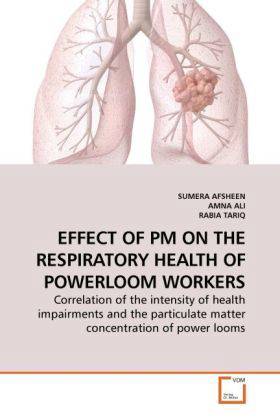
- Afhalen na 1 uur in een winkel met voorraad
- Gratis thuislevering in België vanaf € 30
- Ruim aanbod met 7 miljoen producten
- Afhalen na 1 uur in een winkel met voorraad
- Gratis thuislevering in België vanaf € 30
- Ruim aanbod met 7 miljoen producten
Zoeken
EFFECT OF PM ON THE RESPIRATORY HEALTH OF POWERLOOM WORKERS
Correlation of the intensity of health impairments and the particulate matter concentration of power looms
Sumera Afsheen, Amna Ali, Rabia Tariq
Paperback | Engels
€ 64,45
+ 128 punten
Omschrijving
Environmental and occupational respiratory diseases account for a significant portion of preventable illnesses and premature death in the world. People who work in power looms constantly inhale fibers and encounter several respiratory disorders e.g. byssinosis caused by cotton dust. Especially PM2.5 µm can reach into the deepest recesses of the lungs, where they remain trapped in the lung tissue for years, and can cause and aggravate certain respiratory diseases e.g. chronic bronchitis, emphysema and also heart diseases. No effective cures for diseases caused by PM are known yet; it is only through prevention that their burden on society can be lessened. Studies narrating the association between PM pollution in work places and respiratory illnesses are scare, so more work is needed to understand such associations. Therefore a survey was conducted in power looms with special focus on correlation between intensity of health impairments and the particulate matter concentration of power looms.
Specificaties
Betrokkenen
- Auteur(s):
- Uitgeverij:
Inhoud
- Aantal bladzijden:
- 68
- Taal:
- Engels
Eigenschappen
- Productcode (EAN):
- 9783639248210
- Verschijningsdatum:
- 28/04/2010
- Uitvoering:
- Paperback
- Afmetingen:
- 152 mm x 229 mm
- Gewicht:
- 113 g

Alleen bij Standaard Boekhandel
+ 128 punten op je klantenkaart van Standaard Boekhandel
Beoordelingen
We publiceren alleen reviews die voldoen aan de voorwaarden voor reviews. Bekijk onze voorwaarden voor reviews.








